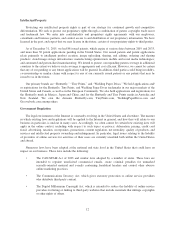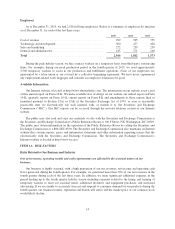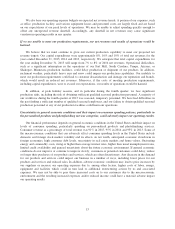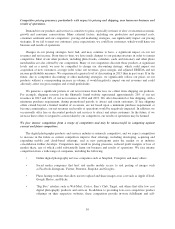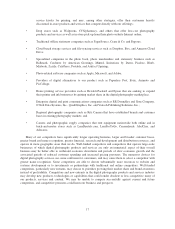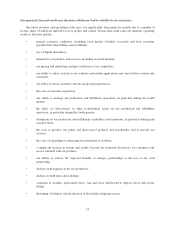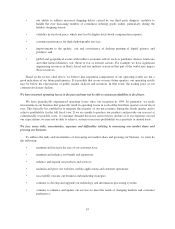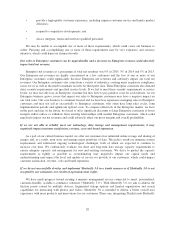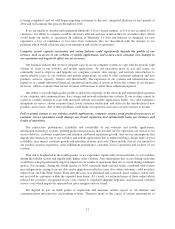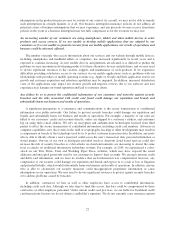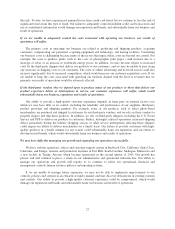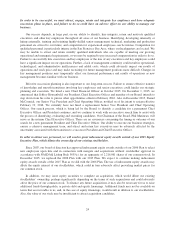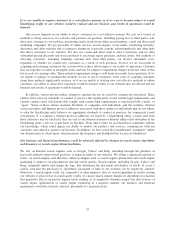Shutterfly 2015 Annual Report Download - page 24
Download and view the complete annual report
Please find page 24 of the 2015 Shutterfly annual report below. You can navigate through the pages in the report by either clicking on the pages listed below, or by using the keyword search tool below to find specific information within the annual report.interruptions in the production process may be outside of our control. As a result, we may not be able to remedy
such interruptions in a timely manner, or at all. Our business interruption insurance policies do not address all
potential causes of business interruptions that we may experience, and any proceeds we may receive from these
policies in the event of a business interruption may not fully compensate us for the revenues we may lose.
An increasing number of our customers are using smartphones, tablets and other mobile devices to order
products and access services. If we are unable to develop mobile applications that are adopted by our
customers or if we are unable to generate revenue from our mobile applications, our results of operations and
business could be adversely affected.
The number of people who access information about our services and our website through mobile devices,
including smartphones and handheld tablets or computers, has increased significantly in recent years and is
expected to continue increasing. As new mobile devices and platforms are released, it is difficult to predict the
problems we may encounter in developing products for these alternative devices and platforms, and we may need
to devote significant resources to the creation, support, and maintenance of such products. If we experience
difficulties providing satisfactory access to our services via our mobile applications, such as, problems with our
relationships with providers of mobile operating systems (e.g. Apple or Google and their application stores) our
growth and customer acquisition and retention capabilities may be impaired. In addition, increased distribution
costs of the applications may impact net revenue growth and negative reviews due to our software and user
experience may damage our brand reputation and lead to customer churn.
Any failure by us to protect the confidential information of our customers and networks against security
breaches and the risks associated with credit card fraud could damage our reputation and brands and
substantially harm our business and results of operations.
A significant prerequisite to e-commerce and communications is the secure transmission of confidential
information over public networks. Our failure to prevent security breaches could damage our reputation and
brands and substantially harm our business and results of operations. For example, a majority of our sales are
billed to our customers’ credit card accounts directly, orders are shipped to a customer’s address, and customers
log on using their e-mail address. We rely on encryption and authentication technologies licensed from third
parties to effect the secure transmission of confidential information, including credit card numbers. Advances in
computer capabilities, new discoveries in the field of cryptography, hacking or other developments may result in
a compromise or breach of the technology used by us to protect customer transaction data. In addition, any party
who is able to illicitly obtain a user’s password could access the user’s transaction data, personal information or
stored images. Our use of our own as third-party provided (such as Amazon) cloud based services could also
increase the risk of security breaches as cyber-attacks on cloud environments are increasing to almost the same
level as attacks on traditional information technology systems. For example, in 2014, we experienced a cyber-
attack on our Tiny Prints, Treat and Wedding Paper Divas websites, which may have exposed the email
addresses and encrypted passwords used by our customers to login to their accounts. We encrypt customer credit
and debit card information, and we have no evidence that such information was compromised; however, any
compromise of our security could damage our reputation and brands and expose us to a risk of loss or litigation
and potential liability, which would substantially harm our business and results of operations. In addition, anyone
who is able to circumvent our security measures could misappropriate proprietary information or cause
interruptions in our operations. We may need to devote significant resources to protect against security breaches
or to address problems caused by breaches.
In addition, contractors we hire as well as other employees have access to confidential information,
including credit card data. Although we take steps to limit this access, this data could be compromised by these
contractors or other employee personnel. Under current credit card practices, we are liable for fraudulent credit
card transactions because we do not obtain a cardholder’s signature. We do not currently carry insurance against
22


